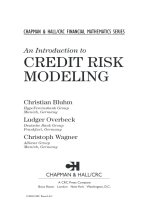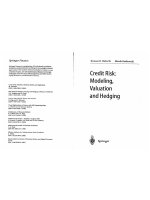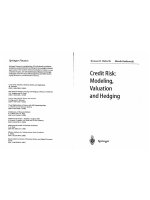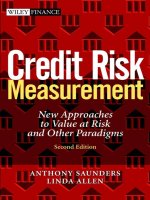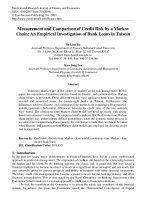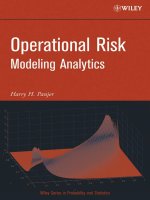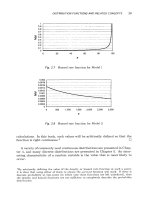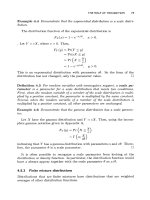credit risk modeling
Bạn đang xem bản rút gọn của tài liệu. Xem và tải ngay bản đầy đủ của tài liệu tại đây (4.98 MB, 285 trang )
©2003 CRC Press LLC
Preface
In banking, especially in risk management, portfolio management, and
structured finance, solid quantitative know-how becomes more and
more important. We had a two-fold intention when writing this book:
First, this book is designed to help mathematicians and physicists
leaving the academic world and starting a profession as risk or portfolio
managers to get quick access to the world of credit risk management.
Second, our book is aimed at being helpful to risk managers looking
for a more quantitative approach to credit risk.
Following this intention on one side, our book is written in a Lecture
Notes style very much reflecting the keyword “introduction” already
used in the title of the book. We consequently avoid elaborating on
technical details not really necessary for understanding the underlying
idea. On the other side we kept the pres entation mathematically pre-
cise and included some proofs as well as many references for readers
interested in diving deeper into the mathematical theory of credit risk
management.
The main focus of the text is on portfolio rather than single obligor
risk. Consequently correlations and factors play a major role. More-
over, most of the theory in many aspects is based on probability theory.
We therefore recommend that the reader consult some standard text
on this topic before going through the material presented in this book.
Nevertheless we tried to keep it as self-contained as possible.
Summarizing our motivation for writing an introductory text on
credit risk management one could say that we tried to write the book we
would have liked to read before starting a profession in risk management
some years ago.
Munich and Frankfurt, August 2002
Christian Bluhm, Ludger Overb eck, Christoph Wagner
©2003 CRC Press LLC
Acknowledgements
Christian Bluhm would like to thank his wife Tabea and his children
Sarah and Noa for their patience during the writing of the manuscript.
Without the support of his great family this project would not had
come to an end. Ludger Overbeck is grateful to his wife Bettina and
his children Leonard, Daniel and Clara for their ongoing support.
We very much appreciated feedback, support, and comments on the
manuscript by our colleagues.
Questions and remarks of the audiences of several conferences, sem-
inars and lectures, where parts of the material contained in this book
have been presented, in many ways improved the manuscript. We al-
ways enjoyed the good discussions on credit risk modeling issues with
colleagues from other financial institutions. To the many people dis-
cussing and sharing with us their insights, views, and opinions, we are
most grateful.
Disclaimer
This book reflects the personal view of the authors and not the opin-
ion of Hyp oVe reinsbank, Deutsche Bank, or Allianz. The contents of
the book has been written for educational purposes and is neither an of-
fering for business nor an instruction for implementing a bank-internal
credit risk model. The authors are not liable for any damage arising
from any application of the theory presented in this book.
©2003 CRC Press LLC
About the Authors
Christian Bluhm works for HypoVereinsbank's group portfolio management in
Munich, with a focus on portfolio modeling and risk management instruments.
His main responsibilities include the analytic evaluation of ABS transactions by
means of portfolio models, as introduced in this book.
His first professional position in risk management was with Deutsche
Bank, Frankfurt. In 1996, he earned a Ph.D. in mathematics from the University
of Erlangen-Nuernberg and, in 1997, he was a post-doctoral member of the
mathematics department of Cornell University, Ithaca, New York. He has
authored several papers and research articles on harmonic and fractal analysis of
random measures and stochastic processes. Since he started to work in risk
management, he has continued to publish in this area and regularly speaks at risk
management conferences and workshops.
Christoph Wagner works on the risk methodology team of Allianz Group
Center. His main responsibilities are credit risk and operational risk modeling,
securitization and alternative risk transfer. Prior to Allianz he worked for
Deutsche Bank's risk methodology department. He holds a Ph.D. in statistical
physics from the Technical University of Munich. Before joining Deutsche
Bank he spent several years in postdoctoral positions, both at the Center of
Nonlinear Dynamics and Complex Systems, Brussels and at Siemens Research
Department in Munich. He has published several articles on nonlinear dynamics
and stochastic processes, as well as on risk modeling.
Ludger Overbeck heads the Research and Development team in the Risk
Analytics and Instrument department of Deutsche Bank's credit risk
management function. His main responsibilities are the credit portfolio model
for the group-wide RAROC process, the risk assesement of credit derivatives,
ABS, and other securitization products, and operational risk modeling. Before
joining Deutsche Bank in 1997, he worked with the Deutsche Bundesbank in the
supervision department, examining internal market risk models.
He earned a Ph.D. in Probability Theory from the University of Bonn.
After two post-doctoral years in Paris and Berkeley, from 1995 to 1996, he
finished his Habilitation in Applied Mathematics during his affiliation with the
Bundesbank. He still gives regular lectures in the mathematics department of the
University in Bonn and in the Business and Economics Department at the
University in Frankfurt. In Frankfurt he received a Habilitation in Business and
Economics in 2001. He has published papers in several forums, from
mathematical and statistical journals, journals in finance and economics,
including RISK Magazine and practioners handbooks. He is a frequent speaker
at academic and practioner conferences.
©2003 CRC Press LLC
©2003 CRC Press LLC
Contents
1TheBasicsofCreditRiskManagement
1.1.1TheDefaultProbability
1.1.1.1Ratings
1.1.1.2CalibrationofDefaultProbabilitiesto
Ratings
1.1.2TheExposureatDefault
1.1.3TheLossGivenDefault
1.1ExpectedLoss
1.2.1EconomicCapital
1.2.2TheLossDistribution
1.2.2.1MonteCarloSimulationofLosses
1.2.2.2AnalyticalApproximation
1.2.3ModelingCorrelationsbyMeansofFactorModels
1.2UnexpectedLoss
1.3RegulatoryCapitalandtheBaselInitiative
2ModelingCorrelatedDefaults
2.1.1AGeneralBernoulliMixtureModel
2.1.2UniformDefaultProbabilityandUniformCorre-
lation
2.1TheBernoulliModel
2.2.1AGeneralPoissonMixtureModel
2.2.2UniformDefaultIntensityandUniformCorrelation
2.2ThePoissonModel
2.3BernoulliVersusPoissonMixture
2.4.1CreditMetrics
TM
andtheKMV-Model
2.4.2CreditRisk
+
2.4.3CreditPortfolioView
2.4.3.1CPVMacro
2.4.3.2CPVDirect
2.4.4DynamicIntensityModels
2.4AnOverviewofToday’sIndustryModels
©2003 CRC Press LLC
2.5.1TheCreditMetrics
TM
/KMVOne-FactorModel
2.5.2TheCreditRisk
+
One-SectorModel
2.5.3ComparisonofOne-FactorandOne-SectorModels
2.5One-Factor/SectorModels
2.6.1Copulas:VariationsofaScheme
2.6LossDistributionsbyMeansofCopulaFunctions
2.7WorkingExample:EstimationofAssetCorrelations
3AssetValueModels
3.1IntroductionandaSmallGuidetotheLiterature
3.2.1GeometricBrownianMotion
3.2.2PutandCallOptions
3.2AFewWordsaboutCallsandPuts
3.3.1CapitalStructure:Option-TheoreticApproach
3.3.2AssetfromEquityValues
3.3Merton’sAssetValueModel
3.4.1Itˆo’sFormula“Light”
3.4.2Black-ScholesPartialDifferentialEquation
3.4TransformingEquityintoAssetValues:AWorkingAp-
proach
4TheCreditRisk+Model
4.1TheModelingFrameworkofCreditRisk
+
4.2ConstructionStep1:IndependentObligors
4.3.1SectorDefaultDistribution
4.3.2SectorCompoundDistribution
4.3.3SectorConvolution
4.3ConstructionStep2:SectorModel
5AlternativeRiskMeasuresandCapitalAllocation
5.1CoherentRiskMeasuresandConditionalShortfall
5.2.1Variance/CovarianceApproach
5.2.2CapitalAllocationw.r.t.Value-at-Risk
5.2.3CapitalAllocationsw.r.t.ExpectedShortfall
5.2.4ASimulationStudy
5.2ContributoryCapital
6TermStructureofDefaultProbability
6.1SurvivalFunctionandHazardRate
6.2Risk-neutralvs.ActualDefaultProbabilities
©2003 CRC Press LLC
6.3.1ExponentialTermStructure
6.3.2DirectCalibrationofMulti-YearDefaultProba-
bilities
6.3.3MigrationTechniqueandQ-Matrices
6.3TermStructureBasedonHistoricalDefaultInformation
6.4TermStructureBasedonMarketSpreads
7CreditDerivatives
7.1TotalReturnSwaps
7.2CreditDefaultProducts
7.3BasketCreditDerivatives
7.4CreditSpreadProducts
7.5Credit-linkedNotes
8CollateralizedDebtObligations
8.1.1TypicalCashFlowCDOStructure
8.1.1.1OvercollateralizationTests
8.1.1.2InterestCoverageTests
8.1.1.3OtherTests
8.1.2TypicalSyntheticCLOStructure
8.1IntroductiontoCollateralizedDebtObligations
8.2.1TheOriginator’sPointofView
8.2.1.1RegulatoryArbitrageandCapitalRelief
8.2.1.2EconomicRiskTransfer
8.2.1.3FundingatBetterConditions
8.2.1.4ArbitrageSpreadOpportunities
8.2.2TheInvestor’sPointofView
8.2DifferentRolesofBanksintheCDOMarket
8.3.1Multi-StepModels
8.3.2CorrelatedDefaultTimeModels
8.3.3StochasticDefaultIntensityModels
8.3CDOsfromtheModelingPointofView
8.4RatingAgencyModels:Moody’sBET
8.5Conclusion
8.6SomeRemarksontheLiterature
©2003 CRC Press LLC
References
List of Figures
1.1 Calibration of Moody's Ratings to Default Probabilities
1.2 The Portfolio Loss Distribution
1.3 An empirical portfolio loss distribution
1.4 Analytical approximation by some beta distribution
1.5 Correlation induced by an underlying factor
1.6 Correlated processes of obligor's asset value log-returns
1.7 Three-level factor structure in KMV's Factor Model
2.1 Today's Best-Practice Industry Models
2.2 Shape of Ganima Distributions for some parameter sets
2.3 CreditMetrics/KMV One-Factor Model: Conditional default
probability as a function of the factor realizations
2.4 CreditMetrics/KMV'One-Factor Model: Conditional default
probability as a function of the average one-year default probability
2.5 The probability density f
ρς
,
2.6 Economic capital EC
α
in dependence on
α
2.7 Negative binomial distribution Nvith parameters (
α
,
β
) = (1,30)
2.8
t
(3)-deilsity versus N(0,1)-density
2.9 Normal versus
t
-dependency with same linear correlation
2.10 Estimated economic cycle compared to Moody's average historic
default frequencies
3.1 Hedging default risk by a long put
3.2 Asset-Equity relation
5.1 Expected Shortfall
5.2 Shortfall contribution versus var/covar-contribution
5.3 Shortfall contribution versus Var/Covar-contribution for business units
6.1 Curnulative default rate for A-rated issuer
6.2 Hazard rate functions
7.1 Total return swap
7.2 Credit default swap
7.3 Generating correlated default times via the copula approach
7.4 The averages of the standard deviation of tire default times, first-to-
default- and last-to-default-time
7.5 kth-to-default spread versus correlation for a basket with three
underlyings
7.6 Default spread versus correlation between reference asset and swap
counterparty
7.7 Credit spread swap
7.8 Example of a Credit-linked Note
8.1 Classification of CDOs
8.2 Example of a cash flow CDO
8.3 Example of waterfalls in a cash flow CDO
8.4 Example of a synthetic CDO
8.5 Equity return distribution of a CDO
8.6 CFO modeling scheme
8.7 CDO modeling workflow based on default times
8.8Diversification Score as a function of m
8.9 Fitting loss distributions by the BET
8.10 Tranching a Loss Distribution
©2003 CRC Press LLC
©2003 CRC Press LLC
Chapter1
TheBasicsofCreditRisk
Management
Whyiscreditriskmanagementanimportantissueinbanking?To
answerthisquestionletusconstructanexamplewhichis,although
simplified,neverthelessnottoounrealistic:Assumeamajorbuilding
companyisaskingitshousebankforaloaninthesizeoftenbillion
Euro.Somewhereinthebank’screditdepartmentasenioranalysthas
thedifficultjobtodecideiftheloanwillbegiventothecustomeror
ifthecreditrequestwillberejected.Letusfurtherassumethatthe
analystknowsthatthebank’schiefcreditofficerhasknownthechief
executiveofficerofthebuildingcompanyformanyyears,andtomake
thingsevenworse,thecreditanalystknowsfromrecentdefaultstudies
thatthebuildingindustryisunderhardpressureandthatthebank-
internalrating
1
ofthisparticularbuildingcompanyisjustontheway
downtoalowsubinvestmentgrade.
Whatshouldtheanalystdo?Well,themostnaturalanswerwould
bethattheanalystshouldrejectthedealbasedontheinformation
sheorhehasaboutthecompanyandthecurrentmarketsituation.An
alternativewouldbetogranttheloantothecustomerbuttoinsurethe
losspotentiallyarisingfromtheengagementbymeansofsomecredit
riskmanagementinstrument(e.g.,aso-calledcreditderivative).
Admittedly,weintentionallyexaggeratedinourdescription,butsit-
uationsliketheonejustconstructedhappenfromtimetotimeandit
isnevereasyforacreditofficertomakeadecisionundersuchdifficult
circumstances.Abrieflookatanytypicalbankingportfoliowillbesuf-
ficienttoconvincepeoplethatdefaultingobligorsbelongtothedaily
businessofbankingthesamewayascreditapplicationsorATMma-
chines.Banksthereforestartedtothinkaboutwaysofloaninsurance
manyyearsago,andtheinsuranceparadigmwillnowdirectlyleadus
tothefirstcentralbuildingblockcreditriskmanagement.
1
Aratingisanindicationofcreditworthiness;seeSection1.1.1.1.
©2003 CRC Press LLC
1.1 Expected Loss
Situations as the one described in the introduction suggest the need
of a loss protection in terms of an insurance, as one knows it from car or
health insurances. Moreover, history shows that even good customers
have a potential to default on their financial obligations, such that an
insurance for not only the critical but all loans in the bank’s credit
portfolio makes much sense.
The basic idea behind insurance is always the same. For example,
in health insurance the costs of a few sick customers are covered by
the total sum of revenues from the fees paid to the insurance company
by all customers. Therefore, the fee that a man at the age of thirty
has to pay for health insurance protection somehow reflects the insur-
ance company’s experience regarding expected costs arising from this
particular group of clients.
For bank loans one can argue exactly the same way: Charging an ap-
propriate risk premium for every loan and collec ting these risk premi-
ums in an internal bank account called expected loss reserve will create
a capital cushion for c overing losses arising from defaulted loans.
In probability theory the attribute expected always refers to an expec-
tation or mean value, and this is also the case in risk management. The
basic idea is as follows: The bank assigns to every customer a default
probability (DP), a loss fraction called the loss given default (LGD),
describing the fraction of the loan’s exposure expected to be lost in
case of default, and the exposure at default (EAD) subject to be lost in
the considered time period. The loss of any obligor is then defined by
a loss variable
˜
L = EAD × LGD × L with L = 1
D
, P(D) = DP, (1. 1)
where D denotes the event that the obligor defaults in a certain pe-
riod of time (most often one year), and P(D) denotes the probability
of D. Although we will not go too much into technical details, we
should mention here that underlying our model is some probability
space (Ω, F, P), consisting of a sample space Ω, a σ-Algebra F, and a
probability measure P. The elements of F are the measurable events of
the model, and intuitively it makes sense to claim that the event of de-
fault should be measurable. Moreover, it is common to identify F with
©2003 CRC Press LLC
the information available, and the information if an obligor defaults or
survives should be included in the set of measurable events.
Now, in this setting it is very natural to define the expected loss (EL)
of any customer as the expectation of its corresponding loss variable
˜
L,
namely
EL = E[
˜
L] = EAD × LGD × P(D) = EAD × LGD × DP, (1. 2)
because the expectation of any Bernoulli random variable, like 1
D
, is
its event probability. For obtaining representation (1. 2) of the EL, we
need some additional assumption on the constituents of Formula (1.
1), for example, the assumption that EAD and LGD are constant val-
ues. This is not necessarily the case under all circumstances. There are
various situations in which, for example, the EAD has to be modeled
as a random variable due to uncertainties in amortization, usage, and
other drivers of EAD up to the chosen planning horizon. In such cases
the EL is still given by Equation (1. 2) if one can assume that the ex-
posure, the loss given default, and the default event D are independent
and EAD and LGD are the expectations of some underlying random
variables. But even the independence assumption is questionable and
in general very much simplifying. Altogether one can say that (1. 2) is
the most simple representation formula for the e xpected loss, and that
the more simplifying assumptions are dropped, the more one moves
away from closed and easy formulas like (1. 2).
However, for now we should not be bothered about the independence
assumption on which (1. 2) is based: The basic concept of expected
loss is the same, no matter if the constituents of formula (1. 1) are
independent or not. Equation (1. 2) is just a convenient way to write
the EL in the first case. Although our focus in the book is on portfo-
lio risk rather than on single obligor risk we briefly describe the three
constituents of Formula (1. 2) in the following paragraphs. Our con-
vention from now on is that the EAD always is a deterministic (i.e.,
nonrandom) quantity, whereas the severity (SEV) of loss in case of de-
fault will be considered as a random variable with expectation given by
the LGD of the respective facility. For reasons of simplicity we assume
in this chapter that the severity is independent of the variable L in (1.
1).
©2003 CRC Press LLC
1.1.1TheDefaultProbability
Thetaskofassigningadefaultprobabilitytoeverycustomerinthe
bank’screditportfolioisfarfrombeingeasy.Thereareessentiallytwo
approachestodefaultprobabilities:
•Calibrationofdefaultprobabilitiesfrommarketdata.
Themostfamousrepresentativeofthistypeofdefaultprobabil-
itiesistheconceptofExpectedDefaultFrequencies(EDF)from
KMV
2
Corporation.WewilldescribetheKMV-ModelinSection
1.2.3andinChapter3.
Anothermethodforcalibratingdefaultprobabilitiesfrommarket
dataisbasedoncreditspreadsoftradedproductsbearingcredit
risk,e.g.,corporatebondsandcreditderivatives(forexample,
creditdefaultswaps;seethechapteroncreditderivatives).
•Calibrationofdefaultprobabilitesfromratings.
Inthisapproach,defaultprobabilitiesareassociatedwithratings,
andratingsareassignedtocustomerseitherbyexternalrating
agencieslikeMoody’sInvestorsServices,Standard&Poor’s
(S&P),orFitch,orbybank-internalratingmethodologies.Be-
causeratingsarenotsubjecttobediscussedinthisbook,we
willonlybrieflyexplainsomebasicsaboutratings.Anexcellent
treatmentofthistopiccanbefoundinasurveypaperbyCrouhy
etal.[22].
Theremainingpartofthissectionisintendedtogivesomebasic
indicationaboutthecalibrationofdefaultprobabilitiestoratings.
1.1.1.1Ratings
Basicallyratingsdescribethecreditworthinessofcustomers.Hereby
quantitativeaswellasqualitativeinformationisusedtoevaluatea
client.Inpractice,theratingprocedureisoftenmorebasedonthe
judgementandexperienceoftheratinganalystthanonpuremathe-
maticalprocedureswithstrictlydefinedoutcomes.Itturnsoutthat
intheUSandCanada,mostissuersofpublicdebtareratedatleast
bytwoofthethreemainratingagenciesMoody’s,S&P,andFitch.
2
KMVCorp.,founded13yearsago,headquarteredinSanFrancisco,developsanddis-
tributescreditriskmanagementproducts;seewww.kmv.com.
©2003 CRC Press LLC
Theirreportsoncorporatebonddefaultsarepubliclyavailable,either
byaskingattheirlocalofficesfortherespectivereportsorconveniently
perwebaccess;seewww.moodys.com,www.standardandpoors.com,
www.fitchratings.com.
In Germany and also in Europe there are not as many companies
issuing traded debt instruments (e.g., bonds) as in the US. Therefore,
many companies in European banking books do not have an external
rating. As a consequence, banks need to invest
3
more effort in their
own bank-internal rating system. The natural candidates for assigning
a rating to a customer are the credit analysts of the bank. Hereby
they have to consider many different drivers of the considered firm’s
economic future:
• Future earnings and cashflows,
• debt, short- and long-term liabilities, and financial obligations,
• capital structure (e.g., leverage),
• liquidity of the firm’s assets,
• situation (e .g., political, social, etc.) of the firm’s home country,
• situation of the market (e.g., industry), in which the company has
its main activities,
• management quality, company structure, etc.
From this by no means exhaustive list it should be obvious that a
rating is an attribute of creditwo rthiness which can not be captured by
a pure mathematical formalism. It is a best practice in banking that
ratings as an outcome of a statistical tool are always re-evaluated by
the rating specialist in charge of the rating process. It is frequently the
case that this re-evaluation moves the rating of a firm by one or more
notches away from the “mathematically” generated rating. In other
words, statistical tools provide a first indication regarding the rating of
a customer, but due to the various soft factors underlying a rating, the
3
Without going into details we would like to add that banks always should base the decision
about creditworthiness on their bank-internal rating systems. As a m ain reason one could
argue that banks know their customers best. Moreover, it is well known tha t external
ratings do not react quick enough to changes in the economic health of a company. Banks
should be able to do it better, at least in the case of their long-term relationship customers.
©2003 CRC Press LLC
responsibilitytoassignafinalratingremainsthedutyoftherating
analyst.
Now,itisimportanttoknowthattheratingagencieshaveestablished
anorderedscaleofratingsintermsofalettersystemdescribingthe
creditworthinessofratedcompanies.TheratingcategoriesofMoody’s
andS&Pareslightlydifferent,butitisnotdifficulttofindamapping
betweenthetwo.Togiveanexample,Table1.1showstherating
categoriesofS&Paspublished
4
in[118].
Asalreadymentioned,Moody’ssystemisslightlydifferentinmean-
ingaswellasinratingletters.TheirratingcategoriesareAaa,Aa,A,
Baa,Ba,B,Caa,Ca,C,wherethecreditworthinessishighestforAaa
andpoorestforC.Moreover,bothratingagenciesadditionallypro-
videratingsonafinerscale,allowingforamoreaccuratedistinction
betweendifferentcreditqualities.
1.1.1.2CalibrationofDefaultProbabilitiestoRatings
Theprocessofassigningadefaultprobabilitytoaratingiscalleda
calibration.Inthisparagraphwewilldemonstratehowsuchacalibra-
tionworks.Theendproductofacalibrationofdefaultprobabilitiesto
ratingsisamapping
Rating→DP,e.g.,{AAA,AA, ,C}→[0,1],R→DP(R),
suchthattoeveryratingRacertaindefaultprobabilityDP(R)is
assigned.
InthesequelweexplainbymeansofMoody’sdatahowacalibration
ofdefaultprobabilitiestoexternalratingscanbedone.FromMoody’s
websiteorfromotherresourcesitiseasytogetaccesstotheirrecent
study[95]ofhistoriccorporatebonddefaults.Thereonecanfindatable
liketheoneshowninTable1.2(see[95]Exhibit40)showinghistoric
default frequencies for the years 1983 up to 2000.
Note that in our illustrative example we chose the fine ratings scale
of Moody’s, making finer differences regarding the creditworthiness of
obligors.
Now, an important observation is that for best ratings no defaults
at all have been observed. This is not as surprising as it looks at first
sight: For example rating class Aaa is often calibrated with a default
probability of 2 bps (“bp” stands for ‘basispoint’ and means 0.01%),
4
Note that we use shorter formulations instead of the exact wording of S&P.
©2003 CRC Press LLC
TABLE 1.1: S&PRatingCategories[118].
4
©2003 CRC Press LLC
TABLE 1.2: Moody’sHistoricCorporateBondDefaultFrequencies.
Rating 1983 1984
1
985 1986 1987 1988
Aaa 0.00% 0.00% 0.00% 0.00% 0.00% 0.00%
Aa1 0.00% 0.00% 0.00% 0.00% 0.00% 0.00%
Aa2 0.00% 0.00% 0.00% 0.00% 0.00% 0.00%
Aa3 0.00% 0.00% 0.00% 0.00% 0.00% 0.00%
A1 0.00% 0.00% 0.00% 0.00% 0.00% 0.00%
A2 0.00% 0.00% 0.00% 0.00% 0.00% 0.00%
A3 0.00% 0.00% 0.00% 0.00% 0.00% 0.00%
Baa1 0.00% 0.00% 0.00% 0.00% 0.00% 0.00%
Baa2 0.00% 0.00% 0.00% 0.00% 0.00% 0.00%
Baa3 0.00% 1.06% 0.00% 4.82% 0.00% 0.00%
Ba1 0.00% 1.16% 0.00% 0.88% 3.73% 0.00%
Ba2 0.00% 1.61% 1.63% 1.20% 0.95% 0.00%
Ba3 2.61% 0.00% 3.77% 3.44% 2.95% 2.59%
B1 0.00% 5.84% 4.38% 7.61% 4.93% 4.34%
B2 10.00% 18.75% 7.41% 16.67% 4.30% 6.90%
B3 17.91% 2.90% 13.86% 16.07% 10.37% 9.72%
Rating 1989 1990
1
991 1992 1993 1994
Aaa 0.00% 0.00% 0.00% 0.00% 0.00% 0.00%
Aa1 0.00% 0.00% 0.00% 0.00% 0.00% 0.00%
Aa2 0.00% 0.00% 0.00% 0.00% 0.00% 0.00%
Aa3 1.40% 0.00% 0.00% 0.00% 0.00% 0.00%
A1 0.00% 0.00% 0.00% 0.00% 0.00% 0.00%
A2 0.00% 0.00% 0.00% 0.00% 0.00% 0.00%
A3 0.00% 0.00% 0.00% 0.00% 0.00% 0.00%
Baa1 0.00% 0.00% 0.76% 0.00% 0.00% 0.00%
Baa2 0.80% 0.00% 0.00% 0.00% 0.00% 0.00%
Baa3 1.07% 0.00% 0.00% 0.00% 0.00% 0.00%
Ba1 0.79% 2.67% 1.06% 0.00% 0.81% 0.00%
Ba2 1.82% 2.82% 0.00% 0.00% 0.00% 0.00%
Ba3 4.71% 3.92% 9.89% 0.74% 0.75% 0.59%
B1 6.24% 8.59% 6.04% 1.03% 3.32% 1.90%
B2 8.28% 22.09% 12.74% 1.54% 4.96% 3.66%
B3 19.55% 28.93% 28.42% 24.54% 11.48% 8.05%
Rating 1995 1996
1
997 1998 1999 2000
Aaa 0.00% 0.00% 0.00% 0.00% 0.00% 0.00%
Aa1 0.00% 0.00% 0.00% 0.00% 0.00% 0.00%
Aa2 0.00% 0.00% 0.00% 0.00% 0.00% 0.00%
Aa3 0.00% 0.00% 0.00% 0.00% 0.00% 0.00%
A1 0.00% 0.00% 0.00% 0.00% 0.00% 0.00%
A2 0.00% 0.00% 0.00% 0.00% 0.00% 0.00%
A3 0.00% 0.00% 0.00% 0.00% 0.00% 0.00%
Baa1 0.00% 0.00% 0.00% 0.00% 0.00% 0.29%
Baa2 0.00% 0.00% 0.00% 0.32% 0.00% 0.00%
Baa3 0.00% 0.00% 0.00% 0.00% 0.34% 0.98%
Ba1 0.00% 0.00% 0.00% 0.00% 0.47% 0.91%
Ba2 0.00% 0.00% 0.00% 0.61% 0.00% 0.66%
Ba3 1.72% 0.00% 0.47% 1.09% 2.27% 1.51%
B1 4.35% 1.17% 0.00% 2.13% 3.08% 3.25%
B2 6.36% 0.00% 1.50% 7.57% 6.68% 3.89%
B3 4.10% 3.36% 7.41% 5.61% 9.90% 9.92%
©2003 CRC Press LLC
essentiallymeaningthatoneexpectsaAaa-defaultinaveragetwicein
10,000years.Thisisalongtimetogo;so,oneshouldnotbesurprised
thatquiteoftenbestratingsarelackofanydefaulthistory.Never-
thelesswebelievethatitwouldnotbecorrecttotakethehistorical
zero-balanceasanindicationthattheseratingclassesarerisk-freeop-
portunitiesforcreditinvestment.Therefore,wehavetofindawayto
assignsmallbutpositivedefaultprobabilitiestothoseratings.
Figure1.1showsour“quick-and-dirtyworkingsolution”oftheprob-
lem,whereweusetheattribute“quick-and-dirty”becauseinpractice
onewouldtrytodothecalibrationalittlemoresophisticatedly
5
.
However,forillustrativepurposesoursolutionissufficient,because
itshowsthemainidea.Wedothecalibrationinthreesteps:
1.Denotebyh
i
(R)thehistoricdefaultfrequencyofratingclass
Rforyeari,whereirangesfrom1983to2000.Forexample,
h
1993
(Ba1)=0.81%.Thencomputethemeanvalueandthe
standarddeviationofthesefrequenciesovertheyears,wherethe
ratingisfixed,namely
m(R)=
1
18
2000
i=1983
h
i
(R)and
s(R)=
1
17
2000
i=1983
h
i
(R)−m(R)
2
.
Themeanvaluem(R)forratingRisourfirstguessofthepoten-
tialdefaultprobabilityassignedtoratingR.Thestandarddevia-
tions(R)givesussomeinsightaboutthevolatilityandtherefore
abouttheerrorweeventuallymakewhenbelievingthatm(R)
isagoodestimateofthedefaultprobabilityofR-ratedobligors.
Figure1.1showsthevaluesm(R)ands(R)fortheconsidered
ratingclasses.Becauseevenbestratedobligorsarenotfreeof
defaultrisk,wewrite“notobserved”inthecellscorresponding
tom(R)ands(R)forratingsR=Aaa,Aa1,Aa2,A1,A2,A3(ratings
wherenodefaultshavebeenobserved)inFigure1.1.
2. Next, we plot the mean values m(R) into a coordinate system,
where the x-axis refers to the rating classes (here numbered from
5
For example, one could look at investment and sub-investment grades se para tely.
©2003 CRC Press LLC
1(Aaa)to16(B3)).OnecanseeinthechartinFigure1.1that
onalogarithmicscalethemeandefaultfrequenciesm(R)canbe
fittedbyaregressionline.Hereweshouldaddacommentthat
thereisstrongevidencefromvariousempiricaldefaultstudies
thatdefaultfrequenciesgrowexponentiallywithdecreasingcred-
itworthiness.Forthisreasonwehavechosenanexponentialfit
(linearonlogarithmicscale).Usingstandardregressiontheory,
see,e.g.,[106]Chapter 4, or by simply using any software provid-
ingbasicstatisticalfunctions,onecaneasilyobtainthefollowing
exponentialfunctionfittingourdata:
DP(x)=3×10
−5
e
0.5075x
(x=1, ,16).
3.Asalaststep,weuseourregressionequationfortheestimation
ofdefaultprobabilitiesDP(x)assignedtoratingclassesxranging
from1to16.Figure1.1showsourresult,whichwenowcalla
calibration of default probabilities to Moody’s ratings. Note that
based on our regression even the be st rating Aaa has a small
but positive default probability. Moreover, our hope is that our
regression analysis has smoothed out sampling errors from the
historically observed data.
Although there is much more to say about default probabilities, we
stop the discussion here. However, later on we will come back to default
probabilities in various c ontexts.
1.1.2 The Exposure at Default
The EAD is the quantity in Equation (1. 2) specifying the exposure
the bank does have to its borrower. In general, the exposure consists
of two major parts, the outstandings and the commitments. The out-
standings refer to the portion of the exposure already drawn by the
obligor. In case of the borrower’s default, the bank is exposed to the
total amount of the outstandings. The commitments can be divided in
two portions, undrawn and drawn, in the time before default. The total
amount of commitments is the exposure the bank has promised to lend
to the obligor at her or his request. Historical default experience shows
that obligors tend to draw on committed lines of credit in times of fi-
nancial distress. Therefore, the commitment is also subject to loss in
case of the obligor’s default, but only the drawn (prior default) amount
©2003 CRC Press LLC
FIGURE 1.1
Calibration of Moody’s Ratings to Default Probabilities
©2003 CRC Press LLC
of the commitments will actually contribute to the loss on loan. The
fraction describing the decomposition of commitments in drawn and
undrawn portions is a random variable due to the optional character
commitments have (the obligor has the right but not the obligation to
draw on committed lines of credit). Therefore it is natural to define
the EAD by
EAD = OUTST + γ × COMM, (1. 3)
where OUTST denotes the outstandings and COMM the commitments
of the loan, and γ is the expected portion of the commitments likely
to be drawn prior to default. More precisely, γ is the expectation of
the random variable capturing the uncertain part of the EAD, namely
the utilization of the undrawn part of the commitments. Obviously, γ
takes place in the unit interval. Recall that we assume the EAD to be
a deterministic (i.e., nonrandom) quantity. This is the reason why we
directly deal with the expectation γ, hereby ignoring the underlying
random variable.
In practice, banks will calibrate γ w.r.t. the creditworthiness of the
borrower and the type of the facility involved.
Note that in many cases, commitments include various so-called
covenants, which are emb edded options either the bank has written
to the obligor or reserved to itself. Such covenants may, for example,
force an obligor in times of financial distress to provide more collateral
6
or to renegotiate the terms of the loan. However, often the obligor
has some informational advantage in that the bank recognizes financial
distress of its borrowers with some delay. In case of covenants allow-
ing the bank to close committed lines triggered by some early default
indication, it really is a question of time if the bank picks up such indi-
cations early enough to react before the customer has drawn on her or
his committed lines. The problem of appropriate and quick action of
the lending institute is especially critical for obligors with former good
credit quality, because banks tend to focus more on critical than on
good customers regarding credit lines (bad customers get much more
attention, because the bank is already “alarmed” and will be more sen-
sitive in case of early warnings of financial instability). Any stochastic
modeling of EAD should take these aspects into account.
6
Collateral means assets securing a loan, e.g., mortgages, bonds, guarantees, etc. In case a
loan defaults, the value of the collateral reduces the loss on the defaulted loan.
©2003 CRC Press LLC
TheBaselCommitteeonBankingSupervision
7
initsrecentconsul-
tativedocument[103]definestheEADforon-balancesheettransactions
tobeidenticaltothenominalamountoftheexposure.
Foroff-balancesheettransactionstherearetwoapproaches:Forthe
foundationapproachthecommitteeproposestodefinetheEADon
commitmentsandrevolvingcreditsas75%oftheoff-balancesheet
amountoftheexposure.Forexample,foracommittedlineofone
billionEurowithcurrentoutstandingsof600million,theEADwould
beequalto600+75%×400=900millionEuro.
Fortheadvancedapproach,thecommitteeproposesthatbanksel-
igibleforthisapproachwillbepermittedtousetheirowninternal
estimatesofEADfortransactionswithuncertainexposure.Fromthis
perspectiveitmakesmuchsenseformajorbankstocarefullythink
aboutsomerigorousmethodologyforcalibratingEADtoborrower-
andfacility-specificcharacteristics.Forexample,banksthatareable
tocalibratetheparameterγin(1.3)onafinerscalewillhavemore
accurateestimatesoftheEAD,betterreflectingtheunderlyingcredit
risk.Themorethedeterminationofregulatorycapitaltendstowards
risksensitivity,themorewillbankswithadvancedmethodologybenefit
fromamoresophisticatedcalibrationofEAD.
1.1.3TheLossGivenDefault
TheLGDofatransactionismoreorlessdeterminedby“1minus
recoveryrate”,i.e.,theLGDquantifiestheportionoflossthebank
willreallysufferincaseofdefault.Theestimationofsuchlossquotes
isfarfrombeingstraightforward,becauserecoveryratesdependon
manydrivingfactors,forexampleonthequalityofcollateral(securities,
mortgages,guarantees,etc.)andontheseniorityofthebank’sclaim
ontheborrower’sassets.Thisisthereasonbehindourconvention
toconsiderthelossgivendefaultasarandomvariabledescribingthe
severityofthelossofafacilitytypeincaseofdefault.ThenotionLGD
thenreferstotheexpectationoftheseverity.
Abank-externalsourceforrecoverydatacomesfromtheratingagen-
cies.ForexampleMoody’s[95]providesrecoveryvaluesofdefaulted
bonds, hereby distinguishing between different seniorities.
7
The Basle Commitee coordinates the rules and guidelines for banking supervision. Its
members are central banks and other national offices or government agencies responsible
for banking supervision.
©2003 CRC Press LLC
Unfortunately many banks do not have good internal data for esti-
mating recovery rates. In fact, although LGD is a key driver of EL,
there is in comparison with other risk drivers like the DP little progress
made in moving towards a sophisticated calibration. There are initia-
tives (for example by the ISDA
8
and other similar organisations) to
bring together many banks for sharing knowledge about their practical
LGD experience as well as current techniques for estimating it from
historical data.
However, one can expect that in a few years LGD databases will have
significantly improved, such that more accurate estimates of the LGD
for certain banking products can be made.
1.2 Unexpected Loss
At the beginning of this chapter we introduced the EL of a transac-
tion as an insurance or loss reserve in order to cover losses the bank
expects from historical default experience. But holding capital as a
cushion against expected losses is not enough. In fact, the bank should
in addition to the expected loss reserve also save money for covering
unexpected losses exceeding the average experienced losses from past
history. As a measure of the magnitude of the deviation of losses from
the EL, the standard deviation of the loss variable
˜
L as defined in (1.
1) is a natural choice. For obvious reasons, this quantity is called the
Unexpected Loss (UL), defined by
UL =
V[
˜
L] =
V
EAD × SEV × L
.
1.2.1 Proposition Under the assumption that the severity and the
default event D are uncorrelated, the unexpected loss of a loan is given
by
UL = EAD ×
V[SEV] × DP + LGD
2
× DP(1 − DP) .
Proof. Taking V[X] = E[X
2
] − E[X]
2
and V[1
D
] = DP(1 −DP) into
account, the assertion follows from a straighforward calculation. ✷
8
International Swap Dealers Association.
©2003 CRC Press LLC
1.2.2RemarkNotethattheassumptionofzerocorrelationbetween
severityanddefaulteventinProposition1.2.1isnotalwaysrealistic
andoftenjustmadetoobtainafirstapproximationtothe“real”un-
expectedloss.Infact,itisnotunlikelythatonaveragetherecovery
rateofloanswilldropifbadeconomicconditionsinduceanincrease
ofdefaultfrequenciesinthecreditmarkets.Moreover,sometypes
ofcollateralbearasignificantportionofmarketrisk,suchthatun-
favourablemarketconditions(whichmightalsobethereasonforan
increasednumberofdefaultevents)implyadecreaseofthecollateral’s
marketvalue.InSection2.5wediscussacasewheretheseverityof
lossesandthedefaulteventsarerandomvariablesdrivenbyacommon
underlyingfactor.
Now,sofarwehavealwayslookedatthecreditriskofasinglefacility,
althoughbankshavetomanagelargeportfoliosconsistingofmany
differentproductswithdifferentriskcharacteristics.Wethereforewill
nowindicatehowonecanmodelthetotallossofacreditportfolio.
Forthispurposeweconsideraportfolioconsistingofmloans
˜
L
i
=EAD
i
×SEV
i
×L
i
,with(1.4)
L
i
=1
D
i
,P(D
i
)=DP
i
.
Theportfoliolossisthendefinedastherandomvariable
˜
L
PF
=
m
i=1
˜
L
i
=
m
i=1
EAD
i
×SEV
i
×L
i
.(1.5)
Analogouslytothe“standalone”quantitiesELandULwenowobtain
portfolioquantitiesEL
PF
andUL
PF
,definedbytheexpectationre-
spectivelystandarddeviationoftheportfolioloss.IncaseofELwe
canusetheadditivityofexpectationstoobtain
EL
PF
=
m
i=1
EL
i
=
m
i=1
EAD
i
×LGD
i
×DP
i
.(1.6)
IncaseoftheUL,additivityholdsifthelossvariables
˜
L
i
arepairwise
uncorrelated(seeBienaym´esTheoremin[7]Chapter8).Iftheloss
variables are correlated, additivity is lost. Unfortunately this is the
standard case, because correlations are “part of the game” and a main
driver of credit risk. In fact, large parts of this book will essentially
©2003 CRC Press LLC
be dealing with correlation modeling. The UL of a portfolio is the first
risk quantity we meet where correlations respectively covariances play
a fundamental role:
UL
P F
=
V[
˜
L
P F
] (1. 7)
=
m
i=1
m
j=1
EAD
i
× EAD
j
× Cov[SEV
i
× L
i
, SEV
j
× L
j
] .
Looking at the special case where severities are constant, we can express
the portfolio’s UL by means of default correlations, namely
1.2.3 Proposition For a p ortfolio with constant severities we have
UL
2
P F
=
m
i,j=1
EAD
i
× EAD
j
× LGD
i
× LGD
j
×
×
DP
i
(1 − DP
i
)DP
j
(1 − DP
j
) ρ
ij
where ρ
ij
= Corr[L
i
, L
j
] = Corr[1
D
i
, 1
D
j
] denotes the default correla-
tion between counterparties i and j.
Proof. The proposition is obvious. ✷
Before continuing we want for a m ome nt to think about the mean-
ing and interpretation of correlation. For simplicity let us consider a
portfolio consisting of two loans with LGD= 100% and EAD= 1. We
then only deal with L
i
for i = 1, 2, and we set ρ = Corr[L
1
, L
2
] and
p
i
= DP
i
. Then, the squared UL of our portfolio is obviously given by
UL
2
P F
= p
1
(1−p
1
)+ p
2
(1−p
2
)+ 2ρ
p
1
(1 − p
1
)
p
2
(1 − p
2
) . (1. 8)
We consider three possible cases regarding the default correlation ρ:
• ρ = 0. In this case, the third term in (1. 8) vanishes, such that
UL
P F
attains its minimum. This is called the case of perfect
diversification. The concept of diversification is e asily explained.
Investing in many different assets generally reduces the overall
portfolio risk, be cause usually it is very unlikely to see a large
number of loans defaulting all at once. The less the loans in the
portfolio have in common, the higher the chance that default of
one obligor does not mean a lot to the economic future of other
©2003 CRC Press LLC
